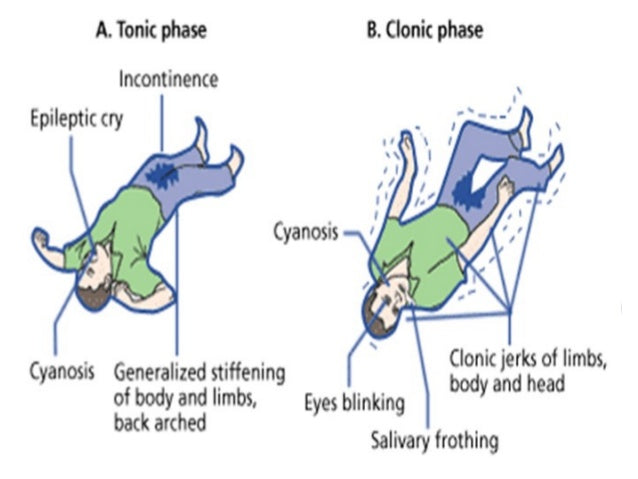What are seizures?
Seizures are sudden onsets of abnormal electrical activities occurring in the brain.
What does a seizure look like?
Contrary to the common misconception : not all seizures require convulsions. Convulsions are involuntary muscles spasms which look like irregular, violent and jerky movements. Although some types of seizures may present with convulsions, not all.
There are two main types of seizures : generalised and partial (focal) seizures. Generalised seizures involve our entire body whereas partial seizures typically affect the head. Here are ways you can identify them :
- Generalised seizures
- Tonic-Clonic
These seizures are very dangerous because they typically present with body stiffening followed by a convulsion (violent and jerky movements) before losing conscious. When they regain consciousness, they will usually be confused.
- Absence
This seizure is an abrupt but short loss of consciousness. Usually, they present as abruptly stopping what they were doing and staring blankly. Unlike the previous, this is a very subtle seizure where it goes unnoticed. Even the affected person may not realize they are experiencing a seizure, but rather they feel as if they “lost time”.
- Myoclonic
These seizures are more closely related to involuntary contractions of the muscle, causing spasms. Typically, the person would suddenly drop or throw an object, involuntarily. Also, they complain of sudden and short electrical shots which cause them to jerk sporadically.
- Clonic
Clonic seizures refers to the jerking convulsion movements. These movements are usually following a pattern that affects both sides. They are repetitive and rhymthic.
- Tonic
Tonic seizures are seizures that present with only stiffening of the muscles. Those affected usually complain of being momentarily paralysed or unable to change their movements.
- Atonic
Atonic seizures are when the body losses its muscle tone (the tone is required to support the weight of our bodies) in the arms and legs. Without muscle tone, our muscles become weak and it results in the patient falling due to lack to support from muscles.
- Partial (Focal) seizures
- Simple
Within simple partial seizures, it can be subcategorised into
- motor (muscle movement)
- muscle rigidity (contraction), spasms, head-turning
- sensory (touch sensation)
- abnormal sensations to the vision, hearing, smell, taste or touch
- psychological
- memory loss or emotional disturbances
- Complex
These seizures involve the patients being unaware or a dazing appearance. Most describe it as “out of touch” or “staring into space”. These present with a variety of repetitive, involuntary but coordinated movements.
What are the causes of seizures?
It is important to note that seizures can present in someone at any point of their life. Therefore, the causes of seizures are vast. Approximately 66% of the time, the cause is idiopathic (unknown). In this case, we tend to strongly associate them with genetics. Apart from genetics, brain malformations, oxygen deprivation, electrolyte abnormalities (especially sugar, calcium and magnesium), brain bleeds, infections, brain tumor, head trauma, stroke, Alzheimer’s disease are all potential causes of seizures.
Difference between seizure and epilepsy
Seizures and epilepsies are usually conceived to be the same thing. However they are not. Seizures are a symptom of epilepsy. Epilepsy is a condition that involves recurrent, intermittent (on-and-off) and spontaneous electrical activity in the brain. To make it easier, epilepsy is a condition diagnosed with multiple seizures occurring over a lifetime whereas a seizure is one episode.
Someone is having a seizure! How do I help?
A seizure is a very scary experience for someone who is non-experienced or who has never seen one. But it is important to constantly stay calm and not panic when the affected person. Firstly, in any emergency situation : call for help.
There is nothing that can be done to stop the seizure (typically last for 60 to 90 minutes), you just have to wait until the seizure ends. In the meantime, you can help by making the affected person comfortable as possible and protecting them from injury.
During the seizure :
- Prevent the affected from falling during a seizure. So lay them down gently to the floor. Place a pillow on their head
- Move away any objects that may be nearby the affected.
- Once the patient has finished seizing, place them on their side and in recovery position
Reminder :
- Do not hold the person down, this will not stop the seizure and it will do more harm to them. Let the seizure ride out.
- Do not insert anything into their mouth. Them biting their tongue or swallowing their tongue is a myth.
- Note how long the seizure lasts, if longer than 5 minutes, call emergency services.
- If you see a pregnant lady seizing, regardless of time, call emergency services.
After the seizure :
- Stay with the affected until they are conscious and alert.
- Check the person for any injuries
- Do not feed, give drink or stand the affected person until they are calm and fully awake and alert.
- Assist the affected person to a nearby hospital for a check-up.
---------------------------------------------------------------------------------------------------------------
Sources :
http://www.webmd.com/epilepsy/understanding-seizures-basics
http://www.epilepsy.com/learn/epilepsy-101/what-causes-epilepsy-and-seizures
http://www.webmd.com/epilepsy/tc/helping-a-person-during-an-epileptic-seizure-topic-overview#1
--------------------------------------------------------------------------------------------------------------
Article is written by:
Fatin Najwa binti Daud, is a medical student studying at IMU Malaysia. She is a freelance writer of this blog at Zaahara. Interests include music, art, sports and travel.
-Photos are taken from google images
© 2016 Zaahara Ventures Sdn. Bhd.



